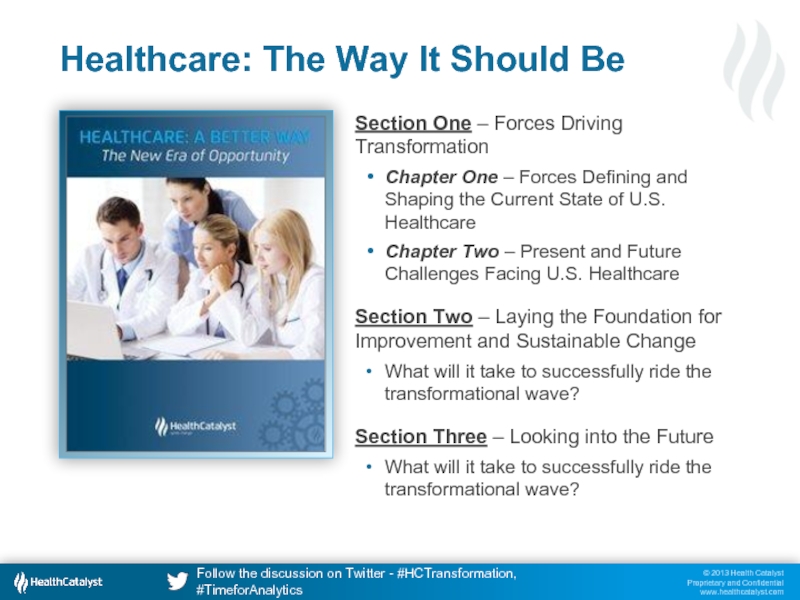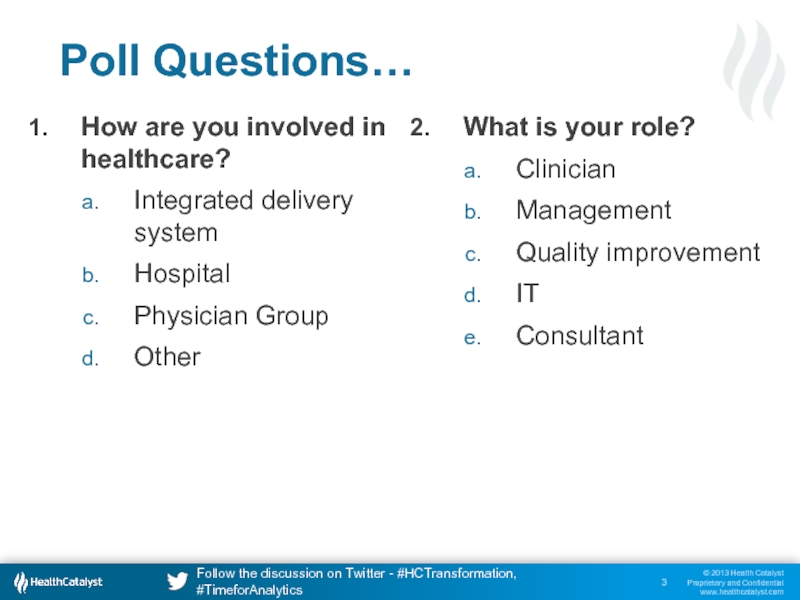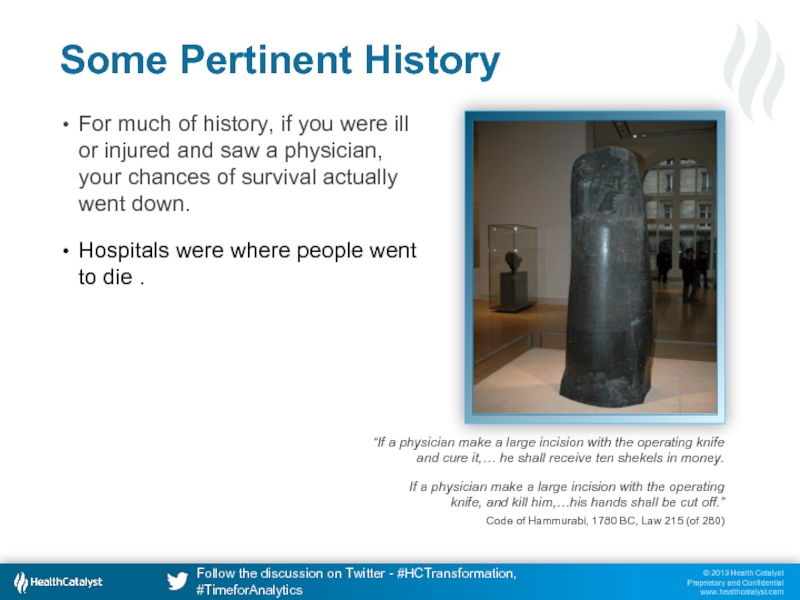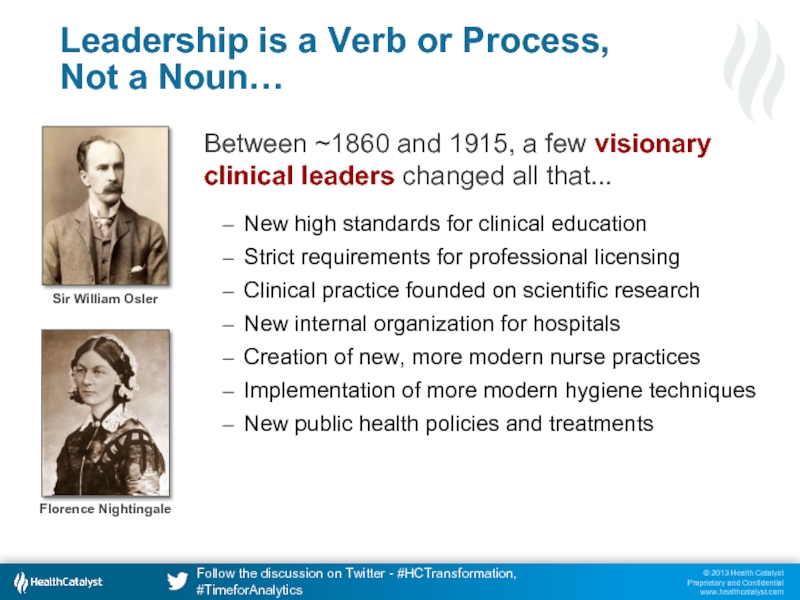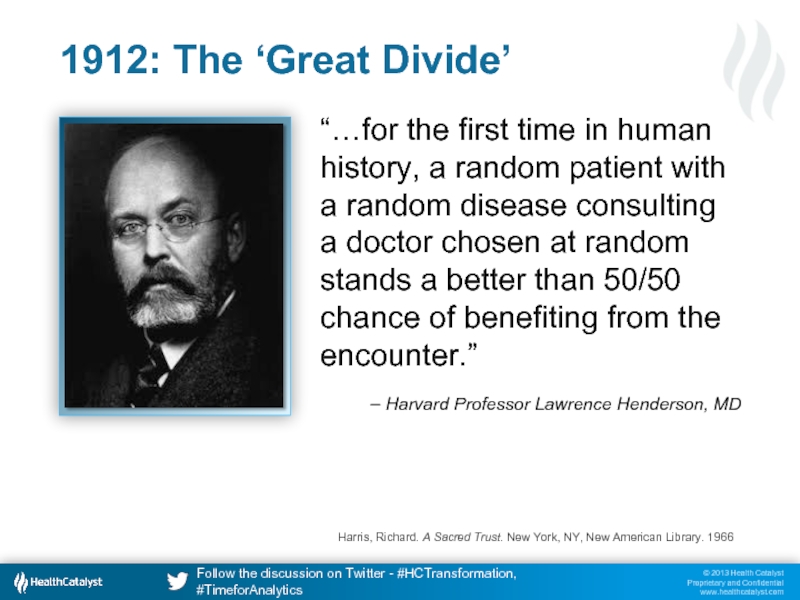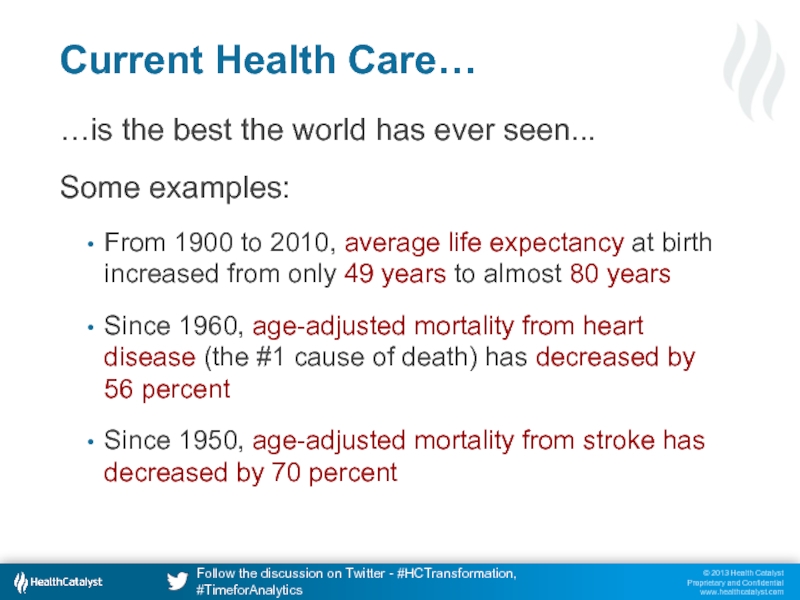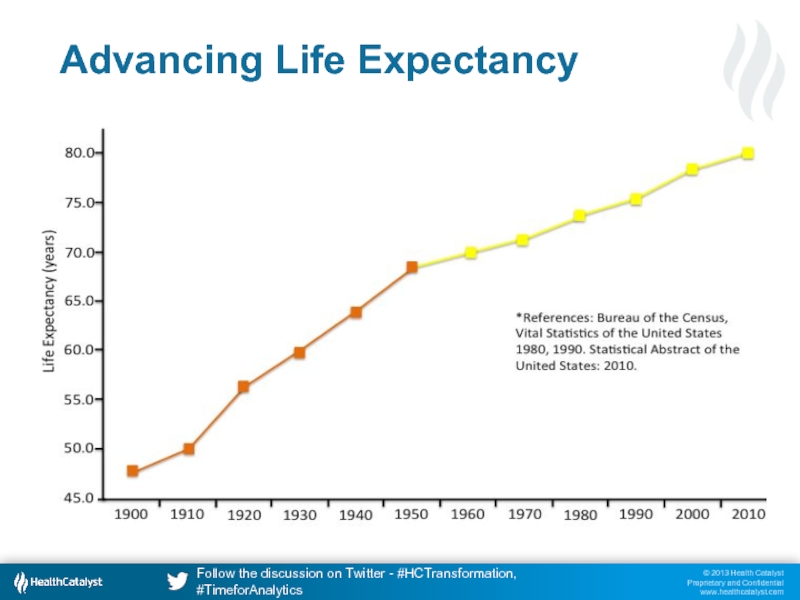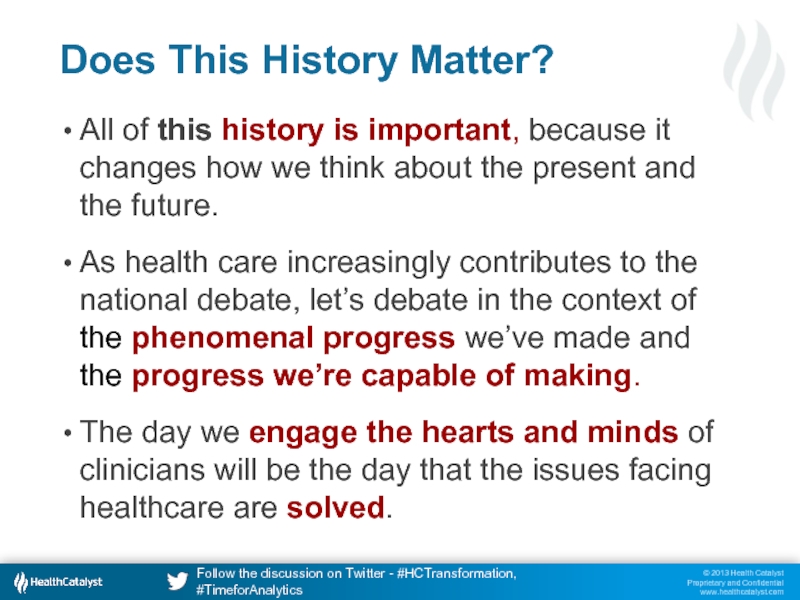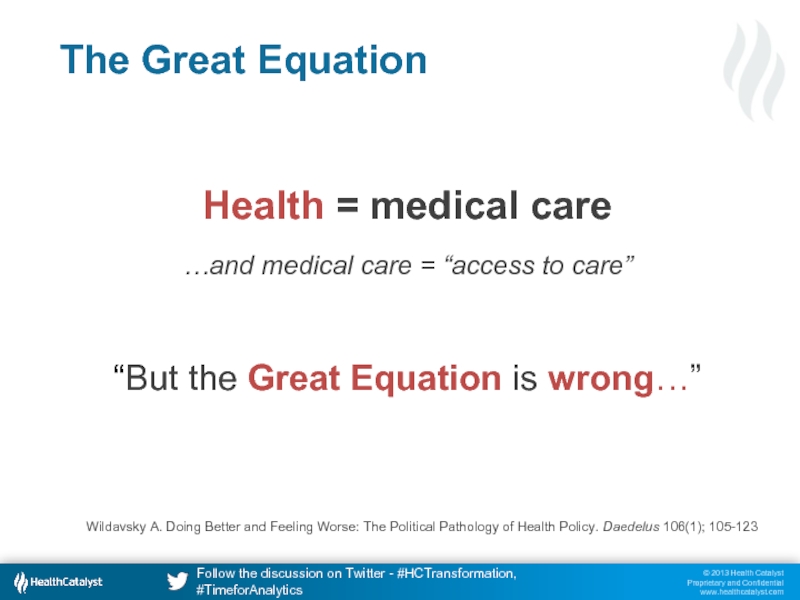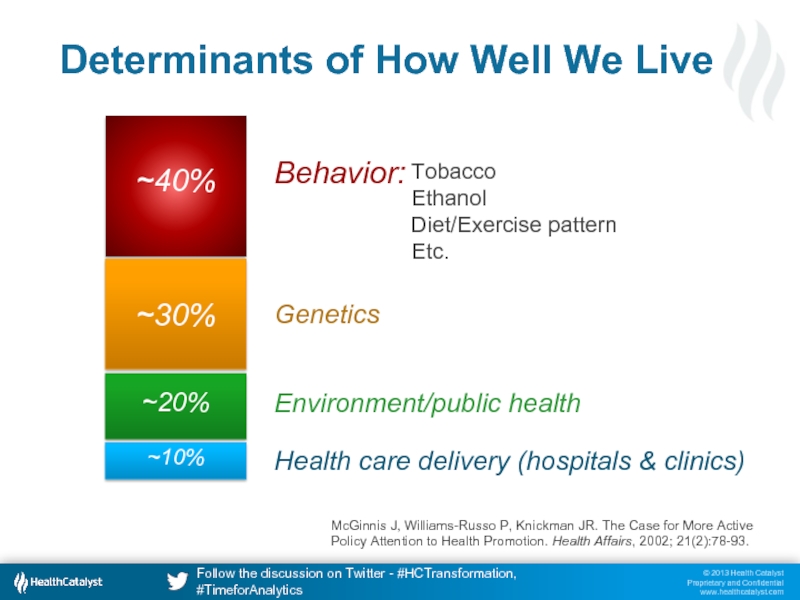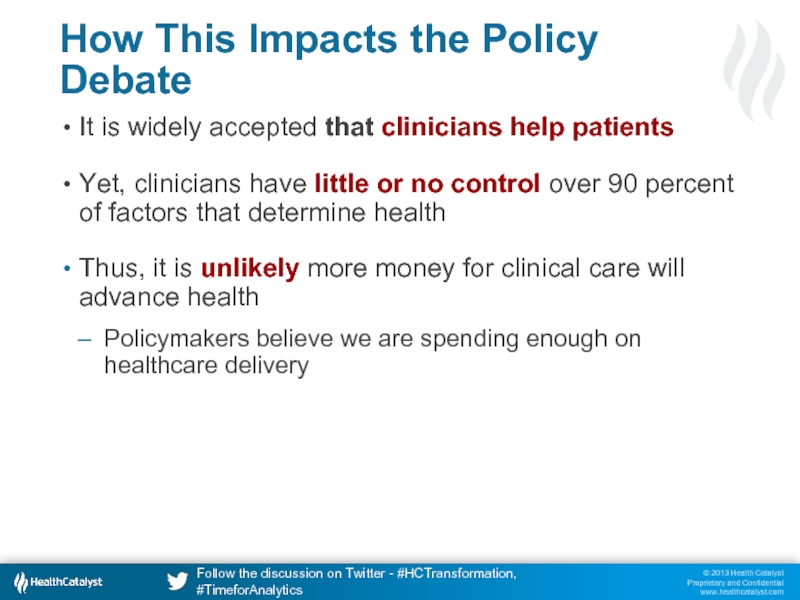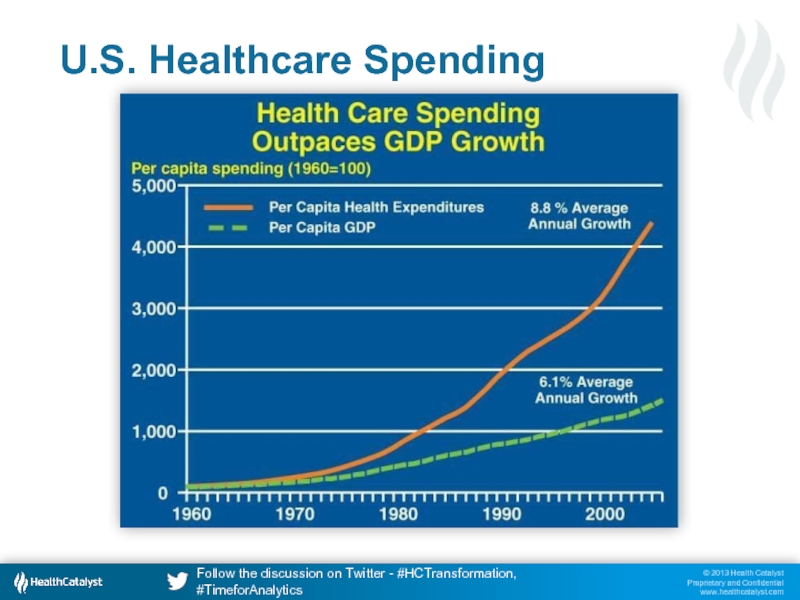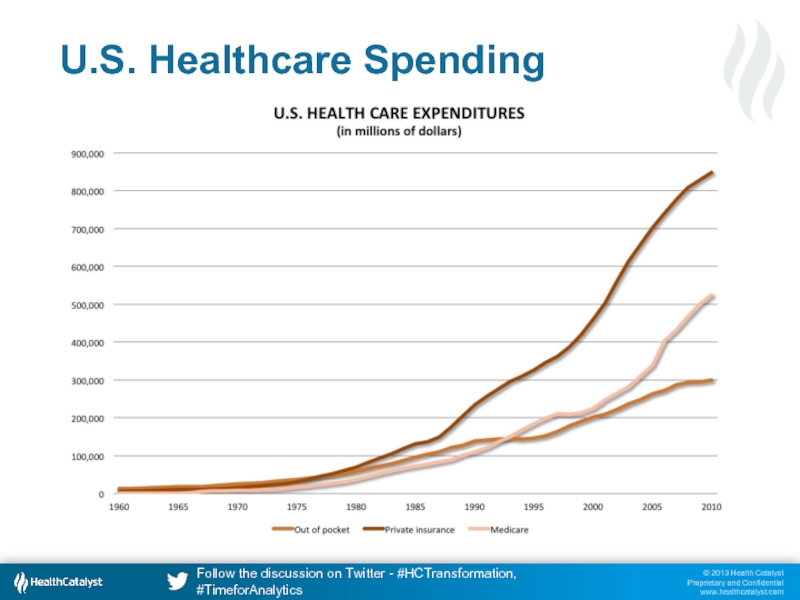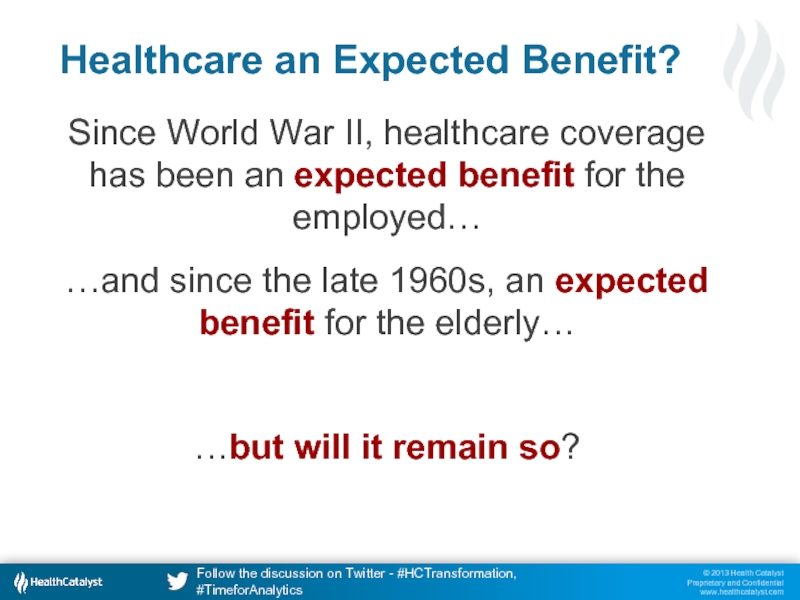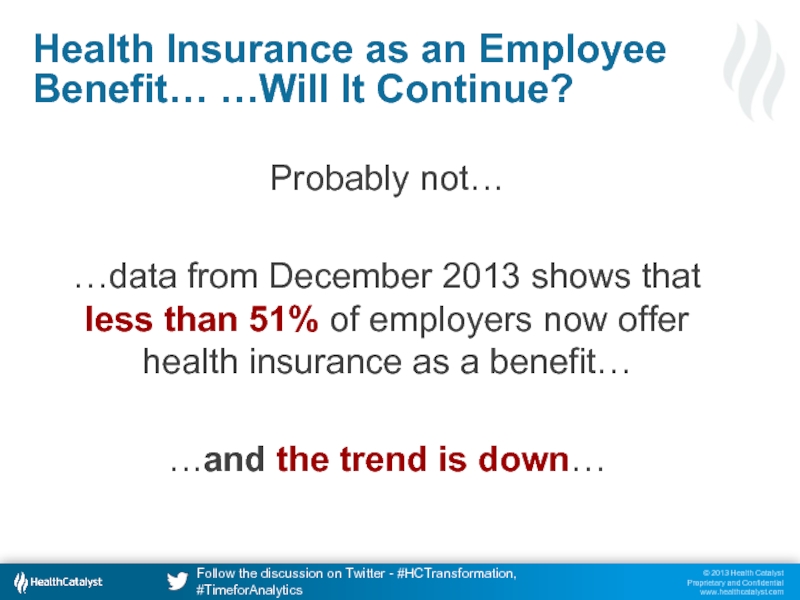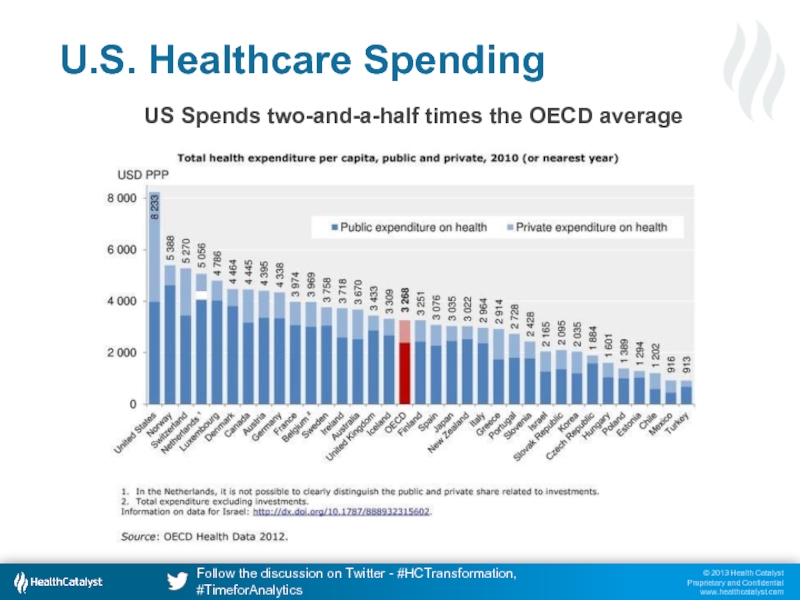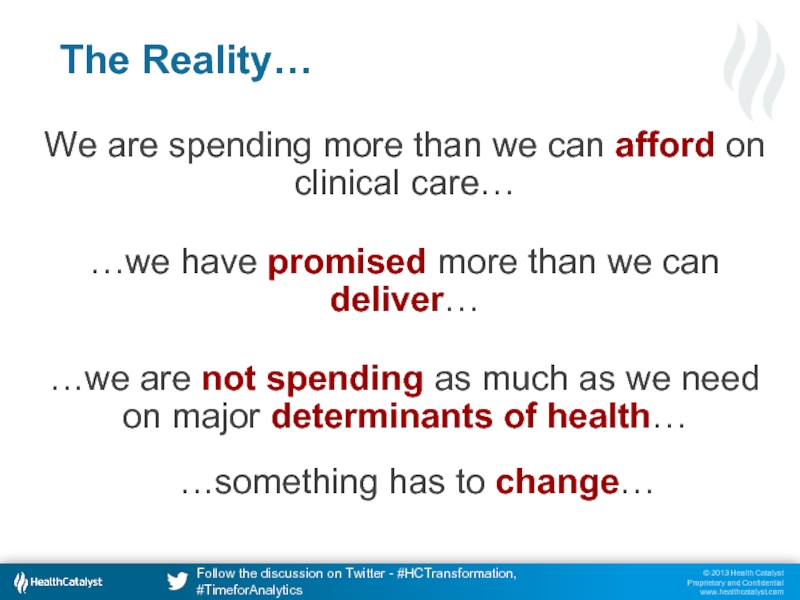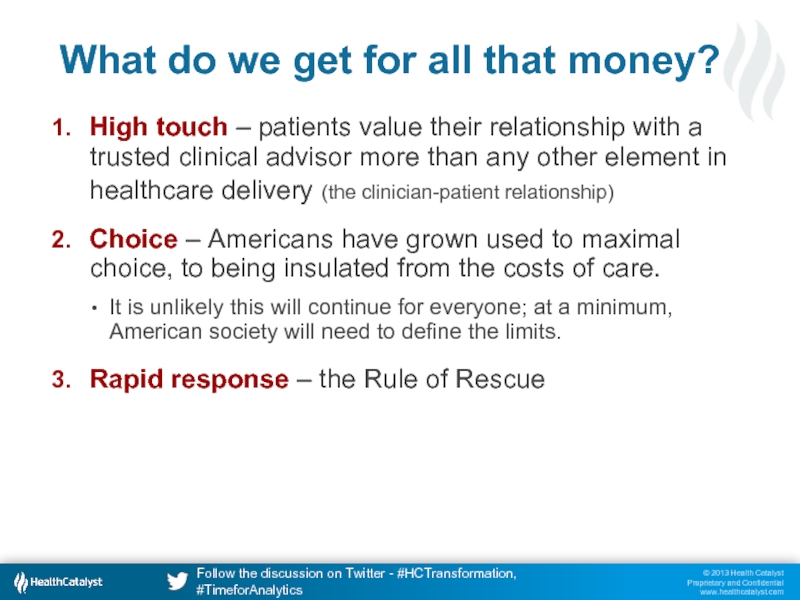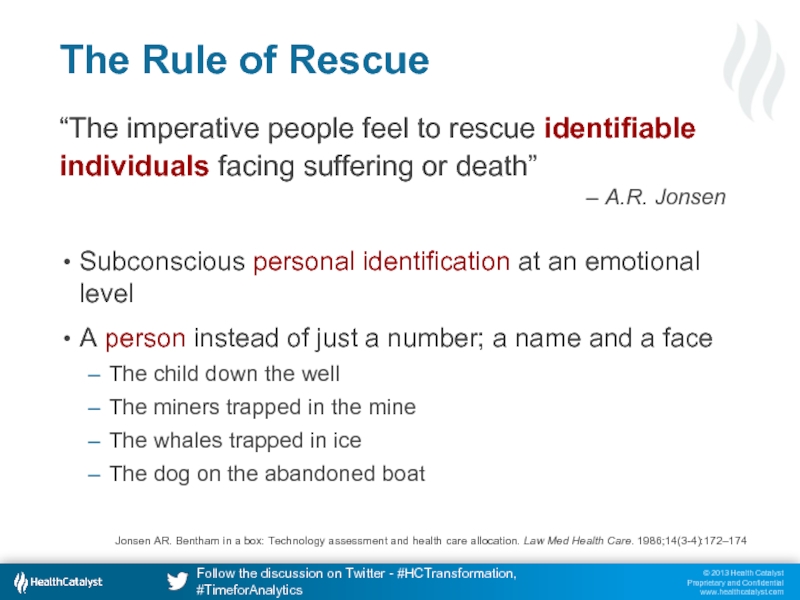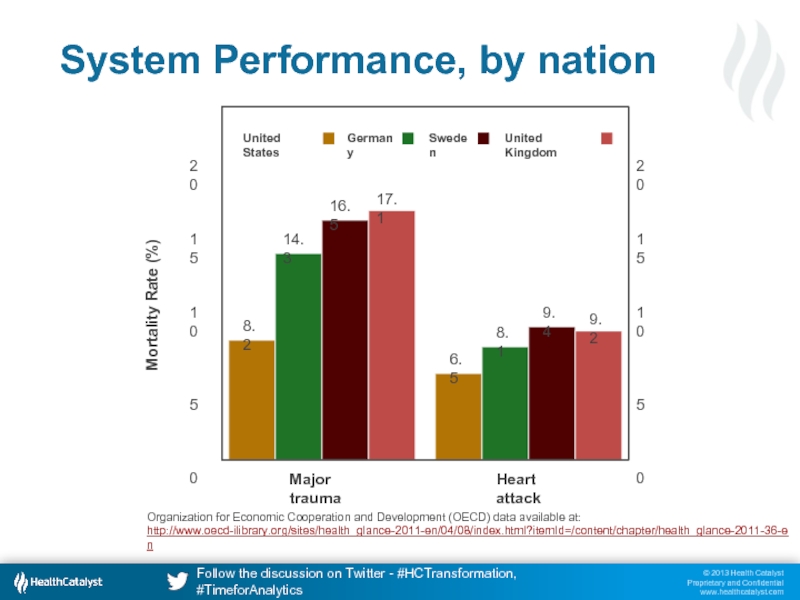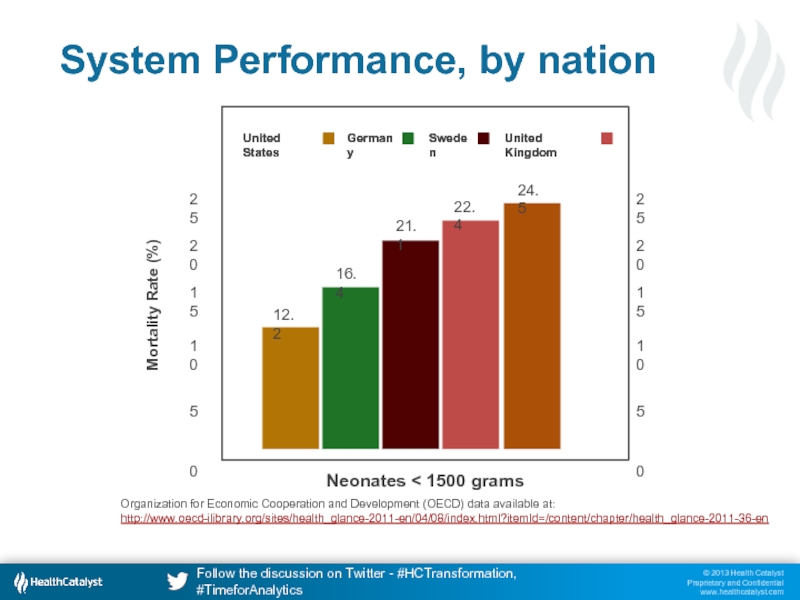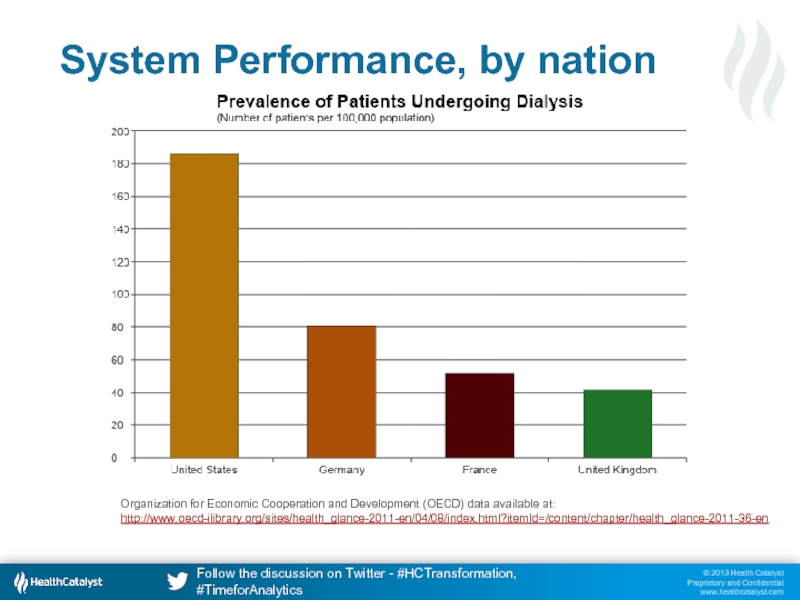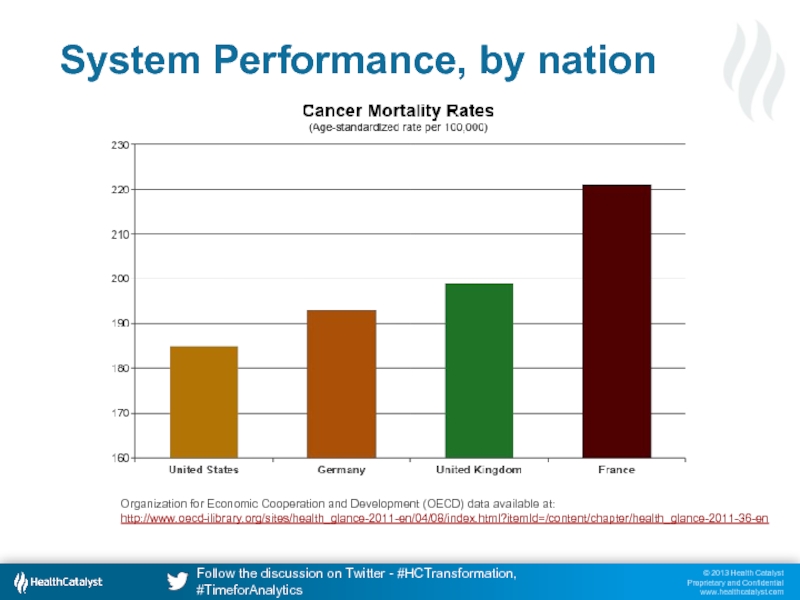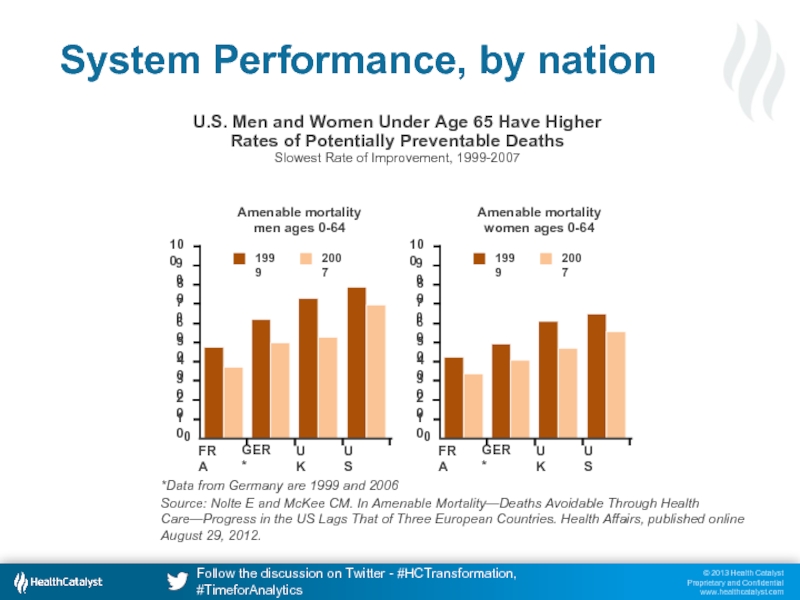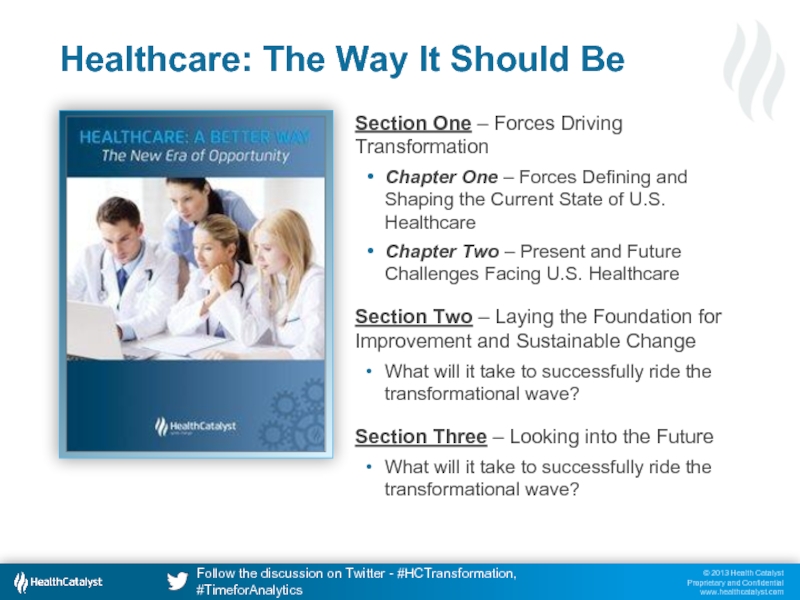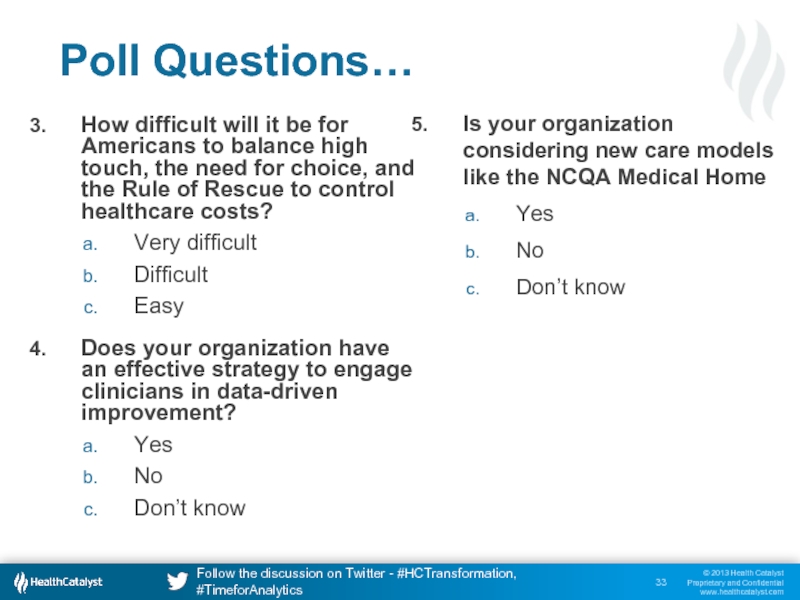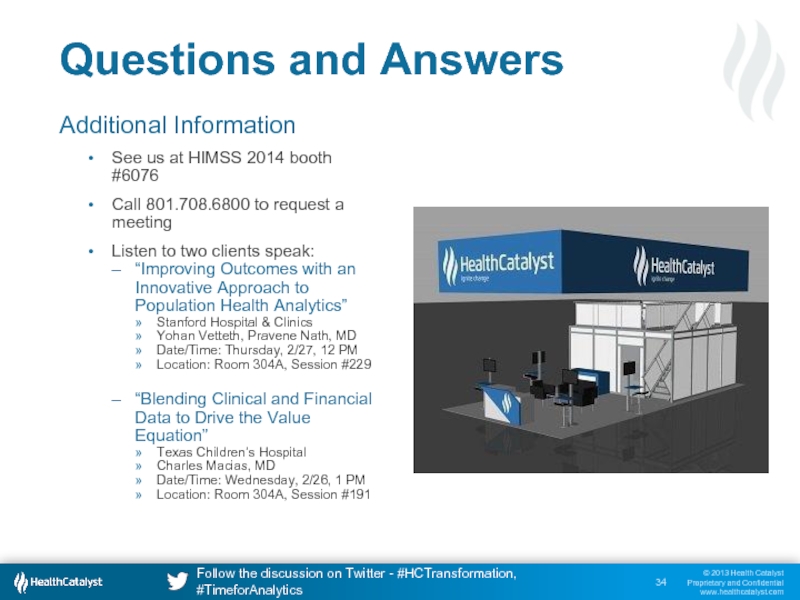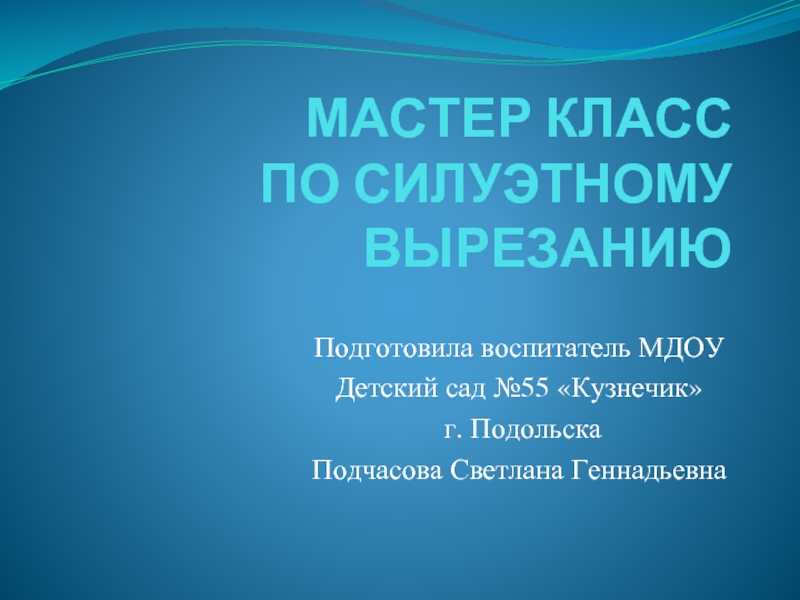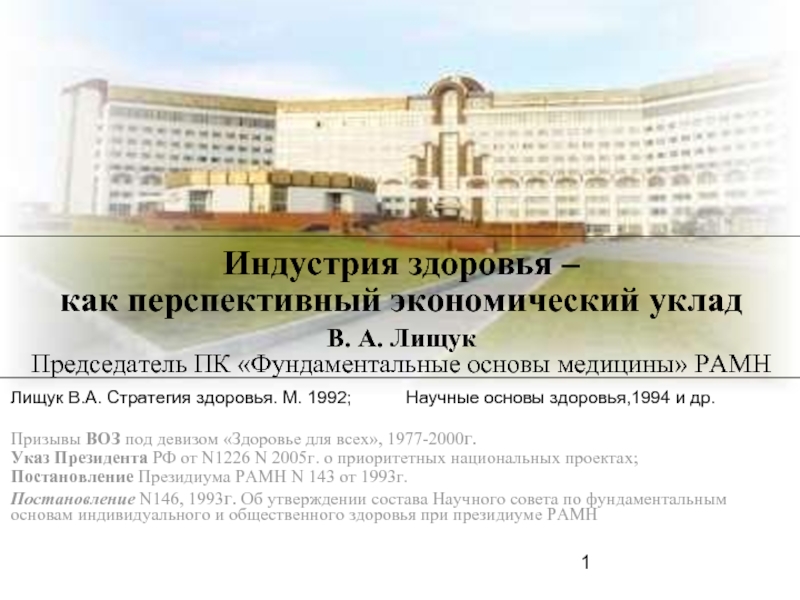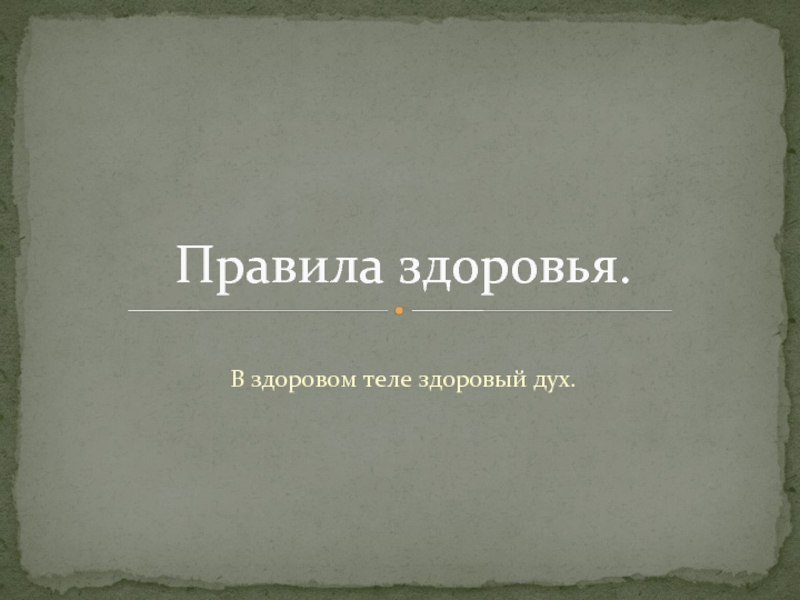- Главная
- Разное
- Дизайн
- Бизнес и предпринимательство
- Аналитика
- Образование
- Развлечения
- Красота и здоровье
- Финансы
- Государство
- Путешествия
- Спорт
- Недвижимость
- Армия
- Графика
- Культурология
- Еда и кулинария
- Лингвистика
- Английский язык
- Астрономия
- Алгебра
- Биология
- География
- Детские презентации
- Информатика
- История
- Литература
- Маркетинг
- Математика
- Медицина
- Менеджмент
- Музыка
- МХК
- Немецкий язык
- ОБЖ
- Обществознание
- Окружающий мир
- Педагогика
- Русский язык
- Технология
- Физика
- Философия
- Химия
- Шаблоны, картинки для презентаций
- Экология
- Экономика
- Юриспруденция
Healthcare: The Way It Should BeThe New Era of Opportunity презентация
Содержание
- 1. Healthcare: The Way It Should BeThe New Era of Opportunity
- 2. Healthcare: The Way It Should Be Section
- 3. Poll Questions… What is your role?
- 4. Some Pertinent History For much of history,
- 5. Leadership is a Verb or Process,
- 6. 1912: The ‘Great Divide’ “…for the first
- 7. Current Health Care… …is the best
- 8. Advancing Life Expectancy
- 9. Some Important Points Most American hospitals and
- 10. Does This History Matter? All of
- 11. The Great Equation Health = medical care
- 12. Determinants of How Well We Live
- 13. How This Impacts the Policy Debate It
- 14. U.S. Healthcare Spending
- 15. U.S. Healthcare Spending
- 16. Healthcare an Expected Benefit? Since World
- 17. Health Insurance as an Employee Benefit… …Will
- 18. U.S. Healthcare Spending
- 19. U.S. Healthcare Spending US Spends two-and-a-half times the OECD average
- 20. The Reality… We are spending more
- 21. A Twofold Solution The solution to this
- 22. High Touch: Caring, not just curing “A
- 23. What do we get for all that
- 24. The Rule of Rescue “The imperative
- 25. System Performance, by nation
- 26. System Performance, by nation
- 27. System Performance, by nation Organization for
- 28. System Performance, by nation Organization for
- 29. System Performance, by nation Organization for
- 30. System Performance, by nation FRA GER*
- 31. In Summary… Over the past century,
- 32. Healthcare: The Way It Should Be Section
- 33. Poll Questions… Is your organization considering
- 34. Questions and Answers Additional Information See us
Слайд 2Healthcare: The Way It Should Be
Section One – Forces Driving Transformation
Chapter One – Forces Defining and Shaping the Current State of U.S. Healthcare
Chapter Two – Present and Future Challenges Facing U.S. Healthcare
Section Two – Laying the Foundation for Improvement and Sustainable Change
What will it take to successfully ride the transformational wave?
Section Three – Looking into the Future
What will it take to successfully ride the transformational wave?
Слайд 3Poll Questions…
What is your role?
Clinician
Management
Quality improvement
IT
Consultant
How are you
Integrated delivery system
Hospital
Physician Group
Other
Слайд 4Some Pertinent History
For much of history, if you were ill or
Hospitals were where people went to die .
“If a physician make a large incision with the operating knife and cure it,… he shall receive ten shekels in money.
If a physician make a large incision with the operating knife, and kill him,…his hands shall be cut off.”
Code of Hammurabi, 1780 BC, Law 215 (of 280)
Слайд 5Leadership is a Verb or Process,
Not a Noun…
Between ~1860
New high standards for clinical education
Strict requirements for professional licensing
Clinical practice founded on scientific research
New internal organization for hospitals
Creation of new, more modern nurse practices
Implementation of more modern hygiene techniques
New public health policies and treatments
Sir William Osler
Florence Nightingale
Слайд 61912: The ‘Great Divide’
“…for the first time in human history, a
– Harvard Professor Lawrence Henderson, MD
Harris, Richard. A Sacred Trust. New York, NY, New American Library. 1966
Слайд 7Current Health Care…
…is the best the world has ever seen...
Some
From 1900 to 2010, average life expectancy at birth increased from only 49 years to almost 80 years
Since 1960, age-adjusted mortality from heart disease (the #1 cause of death) has decreased by 56 percent
Since 1950, age-adjusted mortality from stroke has decreased by 70 percent
Слайд 9Some Important Points
Most American hospitals and caregivers provide safe and effective
The vast majority of caregivers are well trained and conscientious
Western medicine’s ability to save and extend life, and to improve the quality of life for the ill and injured is nothing short of miraculous
Слайд 10Does This History Matter?
All of this history is important, because
As health care increasingly contributes to the national debate, let’s debate in the context of the phenomenal progress we’ve made and the progress we’re capable of making.
The day we engage the hearts and minds of clinicians will be the day that the issues facing healthcare are solved.
Слайд 11The Great Equation
Health = medical care
…and medical care = “access to
“But the Great Equation is wrong…”
Wildavsky A. Doing Better and Feeling Worse: The Political Pathology of Health Policy. Daedelus 106(1); 105-123
Слайд 12Determinants of How Well We Live
Behavior:
Tobacco
Ethanol
Diet/Exercise pattern
Etc.
Genetics
Environment/public health
Health care
~40%
~30%
~20%
~10%
McGinnis J, Williams-Russo P, Knickman JR. The Case for More Active Policy Attention to Health Promotion. Health Affairs, 2002; 21(2):78-93.
Слайд 13How This Impacts the Policy Debate
It is widely accepted that clinicians
Yet, clinicians have little or no control over 90 percent of factors that determine health
Thus, it is unlikely more money for clinical care will advance health
Policymakers believe we are spending enough on healthcare delivery
Слайд 16Healthcare an Expected Benefit?
Since World War II, healthcare coverage has
…and since the late 1960s, an expected benefit for the elderly…
…but will it remain so?
Слайд 17Health Insurance as an Employee Benefit… …Will It Continue?
Probably not…
…data
…and the trend is down…
Слайд 20The Reality…
We are spending more than we can afford on
…we have promised more than we can deliver…
…we are not spending as much as we need on major determinants of health…
…something has to change…
Слайд 21A Twofold Solution
The solution to this national dilemma is twofold:
First, we
Second, we have to spend what we devote to health care more effectively (i.e., generate more value)
…clinician-driven, data-driven quality improvement is the answer…
Слайд 22High Touch: Caring, not just curing
“A man stricken with disease today
Szilagyl DE. In defense of the art of medicine. Archives of Surgery 1965; 91:925-30
Слайд 23What do we get for all that money?
High touch –
Choice – Americans have grown used to maximal choice, to being insulated from the costs of care.
It is unlikely this will continue for everyone; at a minimum, American society will need to define the limits.
Rapid response – the Rule of Rescue
Слайд 24The Rule of Rescue
“The imperative people feel to rescue identifiable
– A.R. Jonsen
Subconscious personal identification at an emotional level
A person instead of just a number; a name and a face
The child down the well
The miners trapped in the mine
The whales trapped in ice
The dog on the abandoned boat
Jonsen AR. Bentham in a box: Technology assessment and health care allocation. Law Med Health Care. 1986;14(3-4):172–174
Слайд 25System Performance, by nation
20
15
10
5
0
20
15
10
5
0
8.2
14.3
16.5
17.1
6.5
8.1
9.4
9.2
Major trauma
Heart attack
Mortality
Organization for Economic Cooperation and Development (OECD) data available at: http://www.oecd-ilibrary.org/sites/health_glance-2011-en/04/08/index.html?itemId=/content/chapter/health_glance-2011-36-en
Слайд 26System Performance, by nation
20
15
10
5
0
20
15
10
5
0
12.2
16.4
21.1
22.4
Neonates < 1500
Mortality Rate (%)
24.5
25
25
Organization for Economic Cooperation and Development (OECD) data available at: http://www.oecd-ilibrary.org/sites/health_glance-2011-en/04/08/index.html?itemId=/content/chapter/health_glance-2011-36-en
Слайд 27System Performance, by nation
Organization for Economic Cooperation and Development (OECD)
Слайд 28System Performance, by nation
Organization for Economic Cooperation and Development (OECD)
Слайд 29System Performance, by nation
Organization for Economic Cooperation and Development (OECD)
Слайд 30System Performance, by nation
FRA
GER*
UK
US
FRA
GER*
UK
US
U.S. Men and Women Under Age 65
Slowest Rate of Improvement, 1999-2007
*Data from Germany are 1999 and 2006
Source: Nolte E and McKee CM. In Amenable Mortality—Deaths Avoidable Through Health Care—Progress in the US Lags That of Three European Countries. Health Affairs, published online August 29, 2012.
Слайд 31In Summary…
Over the past century, remarkable progress was made
We need
Cultural norms—high touch, the desire for choice, and the Rule of Rescue—will likely continue to play a significant role in patient decisions
The pressure to achieve more value from the resources applied to clinical care will grow
Solving healthcare’s issues will be similar to other industries—engaging front line worker in data-driven quality improvement and new, more efficient care delivery models
Слайд 32Healthcare: The Way It Should Be
Section One – Forces Driving Transformation
Chapter One – Forces Defining and Shaping the Current State of U.S. Healthcare
Chapter Two – Present and Future Challenges Facing U.S. Healthcare
Section Two – Laying the Foundation for Improvement and Sustainable Change
What will it take to successfully ride the transformational wave?
Section Three – Looking into the Future
What will it take to successfully ride the transformational wave?
Слайд 33Poll Questions…
Is your organization considering new care models like the
Yes
No
Don’t know
How difficult will it be for Americans to balance high touch, the need for choice, and the Rule of Rescue to control healthcare costs?
Very difficult
Difficult
Easy
Does your organization have an effective strategy to engage clinicians in data-driven improvement?
Yes
No
Don’t know
Слайд 34Questions and Answers
Additional Information
See us at HIMSS 2014 booth #6076
Call 801.708.6800
Listen to two clients speak:
“Improving Outcomes with an Innovative Approach to Population Health Analytics”
Stanford Hospital & Clinics
Yohan Vetteth, Pravene Nath, MD
Date/Time: Thursday, 2/27, 12 PM
Location: Room 304A, Session #229
“Blending Clinical and Financial Data to Drive the Value Equation”
Texas Children’s Hospital
Charles Macias, MD
Date/Time: Wednesday, 2/26, 1 PM
Location: Room 304A, Session #191

